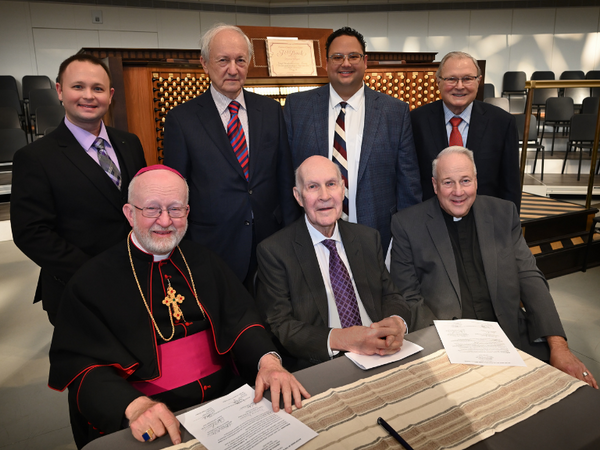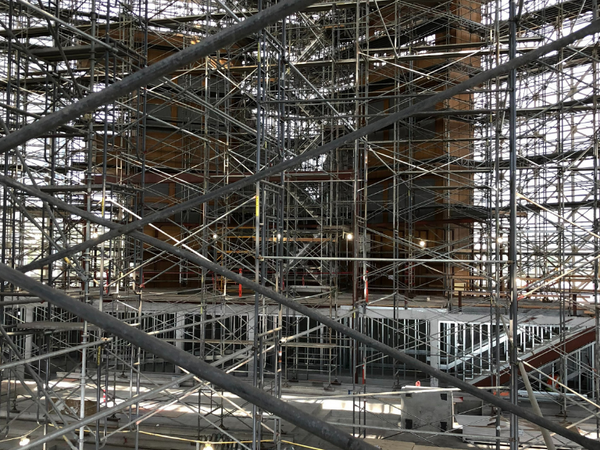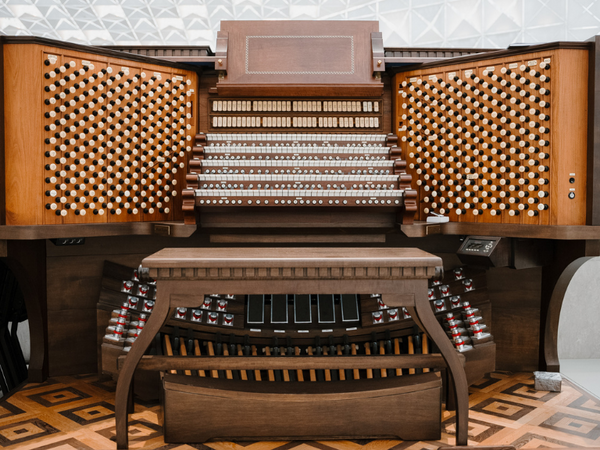Bishop Kevin W. Vann took off his shoes and sat down at the main console of one of the world’s most famous pipe organs. Being shoeless would make it easier to glide over the foot pedals.
Then, during that late-afternoon private preview on June 10, 2022, he played “Ave Maria.”
The majestically soaring voices of the restored Hazel Wright Organ, divided into four sections, reverberated from all corners of Christ Cathedral, creating a powerful “surround sound” experience.
Fr. Christopher Smith, the recently retired rector of the cathedral, followed Bishop Vann’s selection with “Holy, Holy, Holy,” the first hymn he ever heard on the iconic instrument.
“What a blast!” Fr. Christopher exclaimed after playing.
Hours later, a thousand people poured into the cathedral for the public blessing of “Hazel,” as the instrument is affectionately known. Thousands more from around the country tuned in to the event’s livestream.
Bishop Vann, who, like Fr. Christopher, has played the piano and organ since his youth, officiated the blessing, which included biblical readings, prayers and 100 choral singers.
After years of decline and rebirth, Hazel was back.
The saga of the pipe organ begins with her namesake, a Chicago-area donor and the widow of an oil tycoon. Surprisingly, Hazel C. Wright didn’t have a strong connection to music but wanted to donate in a big way to the Rev. Robert Schuller’s “Hour of Power” broadcast from the former Crystal Cathedral, which, at one point, boasted 20 million weekly viewers in 180 countries. Mrs. Wright’s initial $1 million donation funded Hazel and now, 40 years after the instrument’s dedication, the Diocese of Orange has restored her to what experts say is beyond her original glory.
Birth, decline, rebirth.
For Catholics and Christians everywhere, Hazel’s story has a profound resonance.
A DECADE IN THE MAKING
Capping a nearly 10-year restoration odyssey that began not long after the Diocese of Orange finished its purchase of the Crystal Cathedral campus in 2012, Hazel will be celebrated again on Sept. 30, 2022.
An evening dedication concert of the restored Hazel Wright Organ, featuring Hector Olivera, will follow a Q&A with Hazel stakeholders and screening of a new Diocese-produced documentary delving into the history of the majestic instrument.
That day will also kick off the “Year of Hazel” 2022-23 concert series that culminates with a grand performance in June 2023 featuring the Pacific Symphony, Pacific Chorale and Grammy-award winning organist Paul Jacobs.
“Now that Bishop Vann has blessed Hazel, we’re tremendously excited and proud to demonstrate her sheer breadth and beauty,” said David Ball, music ministry director and the cathedral’s principal organist. “While the organ regularly plays at Mass, our Year of Hazel series will give music lovers everywhere a better chance to hear more of what this amazing instrument is truly capable of.”
NO DOUBTS
Bishop Vann, who played piano and organ while growing up in Springfield, Ill., said there was no question that restoring Hazel would be a top priority for the Diocese of Orange as it began settling into its new spiritual home in 2012, the same year he became bishop for Orange County.
“To neglect Hazel or not repair her would not be a good thing,” he said. “There was never any doubt in my mind that it wasn’t going to get done. The organ plays an important part in the Mass. It encourages people to sing and pray, and to hear the presence of God in a way that really nothing else can do.
“In restoring Hazel, I wanted to show everyone that yes, the Catholic Church was going to appreciate this instrument and rebuild her, to help her sing again with the glory of God.”
The process wouldn’t be easy, and like so many other things, it was delayed by the COVID-19 pandemic.
Why the strong push to resurrect Hazel?
Not only did “Hour of Power” make her famous, but with more than 17,000 pipes, 300-plus stops and nearly 300 ranks, she is the world’s fifth largest organ.
She’s the third largest pipe organ in a church (the largest two are in a convention hall and a department store) and the largest organ in a Catholic Church in the Americas, as well as the largest European-made organ in America.
Beyond the superlatives, however, the reason was simple.
“St. Augustine once said, ‘Music is a fair and glorious gift of God,’” Bishop Vann said.
Added Fr. Christopher: “Music is so integral to our liturgies in the Catholic Church, and the organ really is the official instrument of the liturgical life of the church.
“This pipe organ can create a great diversity of sounds, from the tiniest, most quiet little flute or string to magnificent trumpets and horns and basses. And I think that reflects the church and the Diocese of Orange in all its rich diversity.”
BUILT FROM TWO ORGANS
Hazel is primarily a combination of two pipe organs: a 1977 built by the Fratelli Ruffatti company in Padua, Italy — an organ championed by Richard Unfried that was originally installed in the building that today is known as the Arboretum — and a 1962 Aeolian-Skinner from Philharmonic Hall at Lincoln Center in New York City.
Famed organist Virgil Fox played a key role in designing the combined instrument, which was dedicated in the Crystal Cathedral in 1982, two years after the building’s opening. In the ensuing years, Dr. Frederick Swann, then the organist and music director at the Crystal Cathedral, would improve the quality of the massive instrument with constant changes and adjustments throughout his tenure.
Dr. David Crean, an organist at Wright State University in Ohio who has written a recently published book about the history of Hazel, said from the start the pipe organ — despite its grand and awe-inspiring presence and sound — had a lot of elements working against it.
The relentless Southern California sunshine beating through the enormous glass cathedral bent some of Hazel’s pipes. With no HVAC system in the building, the temperature of the pipes varied from hot at the top to cooler at the bottom, making tuning a constant headache.
Leaks in the ceiling drained down the pipes and on her hardened delicate leather pouches, meant to smoothly open and close the instrument’s windchests.
Some of Hazel’s innards were even damaged by rodents, termites, worms and other insects. Some birds flew in from the open side doors of the cathedral and into the pipes — to their demise.
When the Diocese acquired the cathedral and Hazel, she had clearly seen better days.
“The voicing and tone of the organ was in pretty bad condition,” recalled Piero Ruffatti, one of the organ’s original builders in 1977 whose company began refurbishing Hazel after it was dismantled piece by piece in 2014 and shipped in three 40-foot containers to Italy.
He rated Hazel a 5 or 6 out of 10 in terms of optimal condition when his company received her.
Bishop Vann made the decision to have Fratelli Ruffatti bring Hazel back to glorious life.
“Some folks wanted it to be renovated here at home, but I said no,” Bishop Vann recalled. “When you go to your doctor who takes care of you, that’s the best, so we went back to the people who built it and who knew her intimately.”
The cost to restore Hazel eventually would hit $3 million. Scrapping her and purchasing a new pipe organ would have cost at least five times that.
A KEY LIAISON
Gabriel Ferrucci, an Orange County philanthropist, businessman and major Diocese of Orange donor, sat in his home office surrounded by years of Catholic Church memorabilia, including photos of him meeting separately with three popes: Francis, Benedict XVI and St. John Paul II.
He pointed to a statue of St. Cecilia that Bishop Vann gave him when Christ Cathedral was dedicated in July 2019.
“She’s the patron saint of music,” Ferrucci explained.
Although Hazel had been reinstalled in the cathedral by the time of its dedication in 2019, she was not ready for prime time, so the cathedral’s music ministry used a loaned digital organ until Hazel made her private debut during a special signing ceremony on Feb. 7, 2022, after two years — including a COVID-19 pandemic delay — of meticulous tinkering to get her ready for a new curator who would do careful tuning.
Ferrucci was at that ceremony, along with Bishop Vann, Fr. Christopher, Dr. Swann, Ruffatti, David Ball (Christ Cathedral organist and head of music ministry) and Kevin Cartwright of Rosales Organ Builders (Hazel’s new curator). Hours after the signing ceremony, Hazel made her soft-opening debut for the public when she was played during the cathedral’s World Marriage Day Mass.
It was a long and difficult journey restoring Hazel to glory, Ferrucci said.
At the request of Bishop Vann, the native Italian had agreed to serve as a liaison between the diocese and Fratelli Ruffatti. Ferrucci made several trips to Padua, negotiated the contract for the Hazel restoration and oversaw design work.
“It turned out to be a very challenging process,” Ferrucci said. “Without the full support of the bishop, I could not have done it.”
Ruffatti, part of a second generation of brothers in an organ-making family business that dates to 1940, said some of the arduous restoration work in Italy involved climbing up and down ladders some 60 feet tall and using a pulley system to remove large, heavy chests that held Hazel’s large pipes.
Bishop Vann made two trips to Padua during the restoration.
“He’s a very nice person to deal with and communicate with,” said Ruffatti. “He’s very pleasant.”
EVEN BETTER NOW
In 2016, after Hazel returned to Orange County from her refurbishment in Italy, she was stored in a climate-controlled warehouse in Irvine until the transformation of the Crystal Cathedral into Christ Cathedral was completed in 2019.
Her cases were painted white from their original brown to match the cathedral’s new aesthetic.
Ruffatti said Hazel is in better condition now than ever, from both a technical and sound standpoint.
“We’re very proud of the work we’ve done,” added Ruffatti, who will fly out from Italy for the Sept. 30 festivities.
Noting the hard work and many years required to restore Hazel, Bishop Vann observed: “You know what St. Luke says? ‘Nothing is impossible for God.’”
A COLORFUL PALETTE
Crean, who has been good friends with Ball since their days together at The Juilliard School in New York City, notes that the number of people involved in the debut of Hazel back in 1982 and her restoration is extensive.
“Their dedication to see a project like this through is really remarkable,” said Crean, whose main job these days is host and music director for WDPR-FM, Dayton, Ohio’s only full-time classical music station. “You can’t keep an organ like this going with one person. It’s a true team effort.”
Cartwright, who as curator is the maintenance lead and the principal technician of the restored Hazel, said the instrument’s perishable organic material, including leather and rubberized cloth, should help it last another 30 to 50 years before major repairs are needed.
“When they say a pipe organ is alive,” Cartwright said, “it really is in more ways than one.”
He estimates it took “a few hundred goats and sheep and some cows” to glean the leather parts that are inside Hazel.
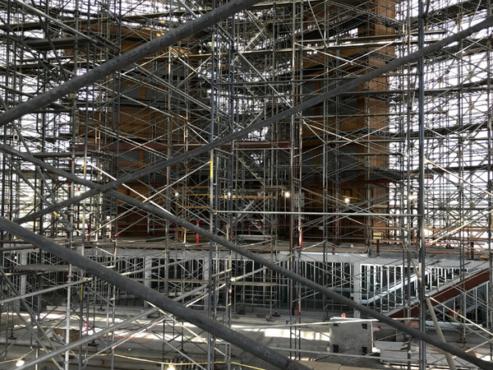
THE HAZEL WRIGHT ORGAN IS SURROUNDED BY SCAFFOLDING DURING ITS DISASSEMBLY PROCESS THAT FINISHED IN 2014. MUCH OF THE ORGAN WAS SENT TO PADUA, ITALY, FOR REFURBISHMENT. PHOTO COURTESY OF THE DIOCESE OF ORANGE
Diocese officials have done all they can to make improvements to the cathedral to ensure that the newly restored Hazel lasts as long as possible.
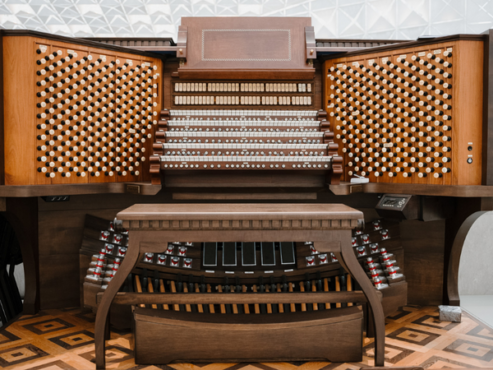
THE RUFFATTI CONSOLE, WHICH IS THE MAIN CONSOLE USED TO PLAY THE HAZEL WRIGHT ORGAN, IS ONE OF THE LARGEST DRAWKNOB
CONSOLES IN THE WORLD. PHOTO COURTESY OF THE DIOCESE OF ORANGE
The $77-million transformation of the 88,000-square-foot Crystal Cathedral into Christ Cathedral included the cleaning and sealing of its more than 10,000 glass panes. Quatrefoils were also installed inside that shade the building, minimizing heat and glare. The quatrefoils and ground-floor stone wall around the cathedral floor also help Hazel’s acoustics, as does the newly installed air conditioning system that the old Crystal Cathedral didn’t have.
The refurbished Hazel also has improved connectivity and updated back-end digital components. It now is connected to the 52-bell Arvella Schuller Carillon inside the Crean Tower next to the cathedral. The carillon can be played from Hazel’s console.
With the flip of a key akin to a car ignition, Hazel gets turned on from the main console in the choir loft of the cathedral.
Making a special appearance to play Hazel at the June 10 blessing was Josep Solé Cole, the principal organist of St. Peter’s Basilica and organist for the liturgical celebrations of Pope Francis.
Cole thanked the bishop for inviting him to the cathedral and allowing him to give Hazel a spin.
Ball, who likens himself to a pilot in a cockpit when he plays Hazel, compares the capabilities of the new and improved Hazel to a box of crayons.
“You can do a lot with an eight-pack of crayons,” Ball said, “but you can do a lot more with 300.”
He added: “It’s always an honor to sit in front of Hazel’s console and play, where I’m continuously in awe of the sheer power and breadth of this amazing instrument. Playing Hazel is literally sitting in the same seat as my musical heroes, people like Virgil Fox who were visionaries in the early days of Hazel to make the dream of this pipe organ a reality.”

